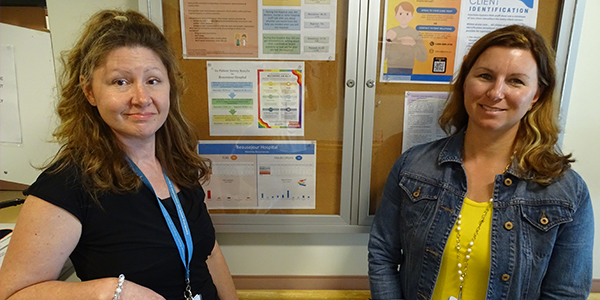Improving the quality of care through patient-centred feedback
Back to Case studies: Working together to make an impact in health care
Prioritizing patients’ experiences and feedback drives interdisciplinary collaboration and improvements in patient-centred care


IERHA’s installation of Quality and Patient Safety boards and the use of data in daily patient safety huddles enable staff to target hospital-specific improvements, demonstrating the value of capturing the patient voice when measuring health system performance.
Customer

CIHI product
Canadian Patient Experiences Survey — Inpatient Care
Background
Prioritizing the patient experience is essential for improving patient-centred care and assessing the effectiveness of Canada’s health systems.
CIHI’s Canadian Patient Experiences Survey — Inpatient Care (CPES-IC) is a standardized tool that hospitals use to gather feedback from patients about the quality of care they received during their most recent stay in a Canadian acute care hospital. It provides a platform for comparisons across sites and over time.
In 2017, Interlake–Eastern Regional Health Authority (IERHA) in Manitoba used the CPES-IC results, alongside other indicators of events like hospital harms and falls, to create and display Quality and Patient Safety boards to support quality improvement initiatives to improve the patient experience.
The challenge
According to CIHI’s report Patient experience in Canadian hospitals, 2019, almost half of patients felt that communication among health care providers could be improved and that health care providers could be more informed about their hospital care.
IERHA needed to use data that included patient voices to identify priority areas for improvement at each hospital and to empower staff to implement targeted interventions. IERHA also needed to improve collaboration and communication among health care providers, as well as between providers and their patients.
The solution

IERHA installed Quality and Patient Safety boards in high-traffic areas at all 10 of its acute care hospitals. These boards highlight key information about each hospital and reflect priority needs. For example, some boards report fall rates, hand hygiene compliance, emergency visit rates and patient experience data.
An important component of these boards is the presentation of 4 or 5 CPES-IC measurement results, which are refreshed monthly.

The impact
Since the introduction of the Quality and Patient Safety boards, IERHA has noticed an increase in teamwork and interdisciplinary collaboration among hospital staff.
The data featured on the boards is used daily in patient safety huddles, where multidisciplinary staff teams — with members ranging from housekeeping to doctors to nurses — are invited to discuss patient-specific changes or concerns, highlighting what is being done well and what could be improved. The boards are placed in locations where everyone can see them, providing full transparency to patients, visitors and staff.
 Staff really appreciate the inpatient experience data. It is helping them understand where improvements can be made. — Tracy Abraham, Director, Health Services, Interlake–Eastern Regional Health Authority
Staff really appreciate the inpatient experience data. It is helping them understand where improvements can be made. — Tracy Abraham, Director, Health Services, Interlake–Eastern Regional Health Authority
The boards
- Identify areas for improvement
- Empower staff to implement site-specific interventions
- Help better meet patient needs
- Lead to creation of site-specific action plans
- Are refreshed monthly with new data or different indicators of interest
New for 2024!
IERHA is expanding the use of Quality and Patient Safety boards in renal and cancer care areas.
A need identified and addressed
IERHA’s installation of Quality and Patient Safety boards and the use of data in daily patient safety huddles enable staff to target hospital-specific improvements, demonstrating the value of capturing the patient voice when measuring health system performance.
Coordination of care involves effective communication among health care providers. This is just as important as communication between health care providers and their patients. A lack of communication can lead to frustration and confusion in patients, system inefficiencies and unintended patient harm.
Having information readily available ensures that patients, caregivers and health care providers are all on the same page.
In 2024, CIHI modernized the CPES-IC to ensure that it continues to align with stakeholder and health system needs; that it remains accessible, relevant, sustainable and patient-centred; and that it is flexible for surveying with 2 versions — the 20M (full survey with 20 measures) and 6M (subset with 6 measures). Our work in IERHA will continue to focus on improvement opportunities by monitoring results over time and comparing with other acute care sites across Manitoba.
Related resources
Contact us
Contact us at this email address:
Back to Case studies: Working together to make an impact in health care
How to cite:
Canadian Institute for Health Information. Improving the quality of care through patient-centred feedback. Accessed April 25, 2025.
If you would like CIHI information in a different format, visit our Accessibility page.

